However, dispensers having a
solid platform must be filled from the top, through the open end of the
barrel, which runs the risk of
spillage if the amount of material discharged into the barrel is not controlled very closely.
Moreover, the top surface of the stick material can present a rough appearance that does not appeal to consumers, so that a subsequent
processing step is needed to create a smooth and acceptable appearance.
A number of problems have been identified in respect of stick dispensers in general and bottom fill stick dispensers in particular.
A
tower, with or without flanges tends to dig into the
skin to a much greater extent than does a flat or domed platform upper surface and is accordingly uncomfortable.
Accordingly, it is considered preferable to employ a skeletal platform, but that has the
disadvantage of having to be deeper than a simple plate, so that the length of the barrel has to be increased to accommodate it.
However, the inventors have further realised that less platform material could equate to thinner elements in a skeletal platform, but thinness increases the risk of flexing, and flexing results in creating fault lines at the junction of stick material and platform element.
Thus, although the problem may be easy to state, the solution is not easy to obtain.
A further problem associated especially with bottom filling of stick dispensers, which commonly occurs under gravity or at a low
pump pressure, is how to control the flow so as to ensure even filling, avoid air pockets and wasteful internal splashing and disruption to the flow as a result particularly of the material encountering the mounting for the spindle and / or particularly elements within the platform en
route to the body of the barrel.
Such needs complicate any solution to maintaining stick adherence and / or reducing the use of resources.
Such
drying out of the stick material often weakens the adherence of the material to the platform so that one or more seals are incorporated at the mounting of the wheel at the base of the barrel and of course the aperture in the wheel is normally plugged.
However, seals typically bridge parallel surfaces of the elements forming the mounting of wheel at the base, and this likewise introduces
dead space in the barrel.
Especially if a full base rotor wheel is employed, this is a relatively slow process.
This arrangement suffers from a number of significant defects.
First, because the platform is inserted by itself into the barrel, there is a
significant risk that if it is allowed to drop into the barrel, it will not drop flat, or may stick.
That substantially slows the
assembly operation because it must be rectified.
Secondly, the means for securing the spindle to the rotor wheel has to have a narrower
diameter than the aperture in the platform for the threaded spindle, so that there is a risk of insecure attachment.
Consequently that is a substantial practical
disadvantage that the spindle tip will not engage the aperture in the rotor wheel squarely, hitting the edge and thus hindering or even halting the
assembly process.
That requires extremely precise
assembly that is rendered very difficult by the remoteness of the spindle tip from the open end of the barrel.
In short, this is a theoretical concept that is impractical to operate.
However, there is a still further
weakness in this proposed dispenser, namely that, the respective screw threads on the spindle and the threaded aperture in the platform must be sufficiently flexible and spaced apart to permit the spindle to be pushed through.
This inevitably reduces the extent of engagement between the respective threads, increasing the risk of disengagement during conventional advancement and retraction operations.
Whilst that is always a risk for a solid platform and a top fill dispenser, the risk would be increased if a skeletal platform were substituted, because the hub of the platform would have significantly reduced lateral support.
Other and further problems associated with bottom fill stick dispensers relate to the
dead space in between the base of the barrel and the platform.
Such space contributes to the weight of the
package and in particular the weight of plastic needed to make the dispenser.
 Login to View More
Login to View More  Login to View More
Login to View More 


